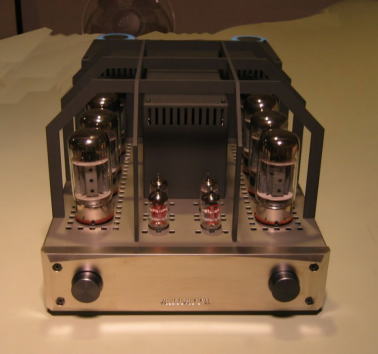Almarro Audio A50125A Integrated Amplifier
| Almarro Audio A50125A Integrated Amplifier |
|
|
|
March 2005 |

Audiophile grade components from Japan
This little adventure started out as a speaker review. Dave Thomas had asked me to look in on a Japanese high-end audio company whose equipment he had first heard at the HE 2003 Show in San Francisco. The name of that was Almarro Audio.
After spending some time perusing the offerings on their website, I was soon in contact with Mr. Yoshihiro Muramatsu in regards to doing a review on one of the company’s newest loudspeakers, the beautiful M50A. Almarro had suggested that I review their A50125A tube integrated amp as well. After collecting the large wood-crated gear from a local U.S. Customs depot, I finally wrestled everything into place in my listening room and prepared to start my preliminary listening. Unfortunately, things didn’t quite work out for the speakers as they suffered some damage during shipping that affected their ability to play properly. But Yoshihiro and I had a pleasant chat and agreed to that I would proceed with reviewing the amplifier.
Almarro Audio is one of the many audiophile companies in Japan that make good sounding, well made components that are slowly making their way here to the states. For years, companies like Sony, Teac, and Onkyo, have been producing high-end quality equipment that never finds its way into the American high-end marketplace. But that’s not to say that no Japanese high-end companies have had success here. Companies such as 47 Laboratory, Wavac, and Audio Note have enjoyed plenty of critical acclaim. Audiophiles and music lovers in general are beginning to discover this fine line of electronic offerings from Japan. Almarro, with its small but growing number of U.S. dealers, should be the next company to be discovered and appreciated for the way it handles music.
The A50125A Integrated Amplifier
From the moment I uncrated the A50125As, I got the feeling that this was not your typical integrated amplifier. The A50125A is a massive, solidly built, 80-pound (!) unit. It uses eight 6550 output tubes in a push-pull configuration to generate a healthy 125 watts per channel. According to Yoshihiro, the intent was to use low amounts of overall negative feedback for a clearer midrange and treble, and cathode negative feedback on the 6550s to get better bass damping. The tubes do generate a lot of heat, but not much more than your typical 100-watt tube based amplifier.
The amp comes with a quasi tube cage that really doesn’t prevent anyone from touching the exposed output tubes (common sense should) so caution needs to be taken when someone is moving around the amplifier while it’s on. The front of the A50125A has the name “Almarro” engraved into its faceplate and two control knobs. The knob on the left is used to select one of three inputs. There are no numbers on the knobs so you will have to count the clicks. The knob on the right is the volume control. I never went past 12 o’clock on the volume control in any of my listening. There are also two shells on the A50125A. The shell in the middle of the A50125A covers the power transformer and a rear shell covers two output transformers. The rear of the amp has a pair of brass five-way binding posts that are of only average quality, but I didn’t have any issues when using them. I was able to bi-wire easily by using one run of cables on the lug and using another set of cables with banana plugs. There are also three sets of input connectors and an On/Off switch. The A50125A is fan protected and the grill for the fan is located on the back as well. The fan is so quiet that you can barely hear it if the room is quiet and you won’t hear it at all when music was playing.
What does it sound like?
The A50125A is a very musical product that shows its tube heritage unashamedly. It is not one of those tube pieces that has tubes but sounds like solid-state. Instruments have bloom and timber, images are dimensional, and performers have a palpable presence across the stage. The A50125A’s performance in the high frequencies is extended and airy. The highs are not as sweet or detailed as say, a Klyne 7LX linestage, but they do sound natural and not at all dark or rolled off. Bass reproduction, while not the A50125A’s strength, is about average for an integrated amp. Though the A50125A is rated at 125 watts, I would not recommend trying to drive speakers as demanding as the Martin-Logan Quests or Von Schweikert VR4.5s with this unit. It will play them without any kind of stress or strain especially if you don’t try to play them too loudly. Besides, you’d be cheating yourself out of the musical treasures to be discovered by partnering it with a speaker that it’s comfortable driving.
 I did my most enjoyable listening to the A50125A while it was used with the wonderful new Von Schweikert Audio VR4jr. This was a good mating and very musically involving. The VR4jr’s are very extended on the top and bottom, and while the A50125A will not push the speakers to the edge of what they can do in the bass, the midrange is flushed out wonderfully. On vocals, the A50125A comes to life and really shows its considerable stuff. On Diana Krall’s Live in Paris [Verve 440 065 109-2], the track “A Case of You”, features her unique vocal style and sumptuous piano playing. The piece is closely miked and she and her piano sounded as if they were in the room with me. Her voice is warm and slightly husky. You can clearly hear her footwork on the piano’s foot pedals, and the inflections in her voice.
I did my most enjoyable listening to the A50125A while it was used with the wonderful new Von Schweikert Audio VR4jr. This was a good mating and very musically involving. The VR4jr’s are very extended on the top and bottom, and while the A50125A will not push the speakers to the edge of what they can do in the bass, the midrange is flushed out wonderfully. On vocals, the A50125A comes to life and really shows its considerable stuff. On Diana Krall’s Live in Paris [Verve 440 065 109-2], the track “A Case of You”, features her unique vocal style and sumptuous piano playing. The piece is closely miked and she and her piano sounded as if they were in the room with me. Her voice is warm and slightly husky. You can clearly hear her footwork on the piano’s foot pedals, and the inflections in her voice.
 Another selection that was eerily real was Mary Stalling’s performing “You Go To My Head”, from the CD Manhattan Moods [Concord Jazz CCD-4750-2]. And yet another treat was listening to the Dan Cray Trio’s no One CD. I’m a big fan of these guys because they all play so well individually, but when they’re playing together, magic just seems to occur. Throughout this disc, Clark Sommers’ basswork and in particular, Greg Wyser-Pratte’s drumwork drives the session. Greg’s speed seems to get more out of his drumming than just background filler. To hear his tempo changes and syncopated beats, your amp needs to have good transient response and this, the A50125A has. String tone is also done very well here.
Another selection that was eerily real was Mary Stalling’s performing “You Go To My Head”, from the CD Manhattan Moods [Concord Jazz CCD-4750-2]. And yet another treat was listening to the Dan Cray Trio’s no One CD. I’m a big fan of these guys because they all play so well individually, but when they’re playing together, magic just seems to occur. Throughout this disc, Clark Sommers’ basswork and in particular, Greg Wyser-Pratte’s drumwork drives the session. Greg’s speed seems to get more out of his drumming than just background filler. To hear his tempo changes and syncopated beats, your amp needs to have good transient response and this, the A50125A has. String tone is also done very well here.
 On another favorite of mine, Appalachian Journey [Sony Classical SK66782], the three virtuosos, Mark O’Connor (violin), Yo-Yo Ma (cello), and Edgar Meyer (bass) are each distinct in their playing styles as are the sounds of their instruments. Each person can be easily followed when listening through the A50125A. Oliver Nelson’s CD, The Blues and The Abstract Truth, contains a classic performance of “Stolen Moments.” The A50125A plays the rich tone of Nelson’s saxophone. Rounding out my selection of digital delights was the Bob James Trio CD Take It From the Top. The A50125A does a fabulous job of conveying the sense of ease and smoothness that Bob James is famous for.
On another favorite of mine, Appalachian Journey [Sony Classical SK66782], the three virtuosos, Mark O’Connor (violin), Yo-Yo Ma (cello), and Edgar Meyer (bass) are each distinct in their playing styles as are the sounds of their instruments. Each person can be easily followed when listening through the A50125A. Oliver Nelson’s CD, The Blues and The Abstract Truth, contains a classic performance of “Stolen Moments.” The A50125A plays the rich tone of Nelson’s saxophone. Rounding out my selection of digital delights was the Bob James Trio CD Take It From the Top. The A50125A does a fabulous job of conveying the sense of ease and smoothness that Bob James is famous for.
I was able to run my phono-rig into the A50125A from my Thor TA-3000 phono stage and with 2m long interconnect on top of that. Trust me, there was more than enough gain for my purposes. I particularly enjoyed listening to The Oscar Peterson Trio’s We Get Requests [Verve Stereo 810 047-1] and The Dave Brubeck Quartet’s At Carnegie Hall. The A50125A does a nice job with chamber music, but for my tastes, it will not do a full-scale orchestral piece quite as well as I would have liked. Don’t get me wrong, it works nicely in a moderately sized room but asking a tubed integrated to fill a room as large as mine is probably not fair. For instance, Antonio Vivaldi’s The Four Seasons [Telarc CD 80070] was rendered beautifully with rich string tone on the violins and cellos, a warm midrange and the high frequencies were extended, but with the Dallas Wind Symphony’s, “Fiesta” [Reference Recordings RR-38], the A50125A had some difficulty reproducing the tympani strikes at the beginning of the piece.
Wrapping it up
The Almarro Audio A50125A integrated amplifier was fun to listen to. Its tube heritage is quite obvious in a pleasant way and its midrange can be addictive. It does not reach far into the deep bass, but the bass that is there is tuneful and has enough heft to it to give the music good foundation. Let’s just say that bass performance is going to be more speaker and room dependent. The A50125A had plenty of gain for any input I wanted to feed into it including the output from my Thor TA-3000 phono preamp. I felt its best performance was with Dynamic Design and Blue Marble Audio cables and interconnects. Bass performance was slightly improved with a delightful new cable Dave Thomas introduced me to, the KAS Audio Primus speaker cable. The competition for integrated amplifiers is increasing at this price point, but I must say that there are not very many vacuum tube integrated available of this size and sound quality. If you like tube equipment and are looking for an integrated amplifier, the A50125A is a good value and a must listen. Recommended.
Michael Wright
_______________
Specifications:
Integrated Amplifier Name: A50125A
Tubes 6550 x 8, 12AT7 x 2, 5687 x 2 in parallel push-pull
Output 125W(stereo), 250W(mono-block)
Frequency Response 15Hz-40KHz +/- 3dB
Dimensions 8″H X 11.2″W X 21″D
Weight 39kg
Price: $2,950
Address:
Almarro Audio
USA Office
1800 Fumia Place
San Jose, CA 95131
Phone 408-375-3799
Japan Office
3489-24 Kitagata Iida-shi Nagano 395-0151 Japan
Phone: +81 265 25 1082
Fax:+81 265 25 8250
http://www.almarro.com
![]()
Don’t forget to bookmark us! (CTRL-SHFT-D)
Stereo Times Masthead
Publisher/Founder
Clement Perry
Editor
Dave Thomas
Senior Editors
Frank Alles, Mike Girardi, Russell Lichter, Terry London, Moreno Mitchell, Paul Szabady, Bill Wells, Mike Wright, and Stephen Yan,
Current Contributors
David Abramson, Tim Barrall, Dave Allison, Ron Cook, Lewis Dardick, John Hoffman, Dan Secula, Don Shaulis, Greg Simmons, Eric Teh, Greg Voth, Richard Willie, Ed Van Winkle, Rob Dockery, Richard Doran, and Daveed Turek
Site Management Clement Perry
Ad Designer: Martin Perry





Be the first to comment on: Almarro Audio A50125A Integrated Amplifier